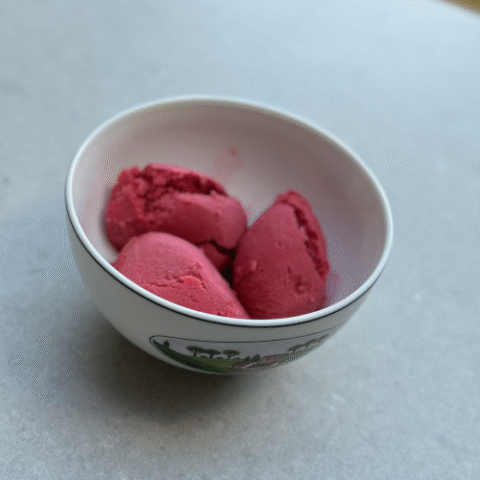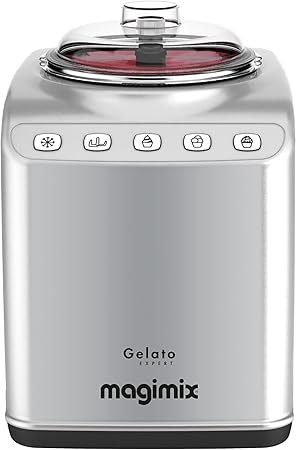
Delicious Beetroot Ice Cream Recipe
Discover this irresistible plant-based beetroot ice cream recipe—creamy, dairy-free, and packed with nutrients. A refreshing vegan dessert that’s as delicious as it is healthy!
Ingredients
- 2 Beets, peeled & grated
- 1 cup/200g Sugar, I used coconut
- 1 cup/250ml Water
- 2 Cans Coconut Milk
- 2 Vanila Bean Pod
- 1 cups/250ml Creamy Non Dairy Milk
- 5 heaped tbs Corn Flour (corn starch)
- 1/2 cup/125ml Maple Nectar
Instructions
- Add the sugar & water to a saucepan, and bring to a simmer. Stir in the grated beets, then let the syrup simmer for 15 minutes.
- Meanwhile, add the coconut milk to a saucepan with the cardamom pods & vanilla. Place the pan over a low heat & allow the mix to infuse for 10 minutes.
- In a small mixing bowl, whisk together the non-dairy milk, cornflour & maple.
- When the coconut milk has infused, whisk in the non-dairy milk mixture, then use a spatula to constantly stir the mix until it starts to thicken up.
- When the syrup has reduced by around a 1/4, strain the mix through a sieve into the cream mixture. Add enough syrup to achieve the colour & beet flavour you require. Any leftover beet can be dried & turned into a vibrant beet powder.
- Once the mix has thickened slightly, pass it through a sieve into a bowl & set aside to cool, cover over directly with greaseproof paper to stop a skin from forming.
- Once cool enough to place in the fridge, refrigerate it completely.
- When the custard has chilled to fridge temperature, add it to your ice cream machine, and let the machine work its magic. When the custard has set into ice cream, transfer it to a freezer-safe container & place it in the freezer to set correctly. Enjoy at your leisure.
Recommended Products
As an Amazon Associate and member of other affiliate programs, I earn from qualifying purchases.
Nutrition Information:
Yield: 8 Serving Size: 1Amount Per Serving: Calories: 434Total Fat: 25gSaturated Fat: 22gTrans Fat: 0gUnsaturated Fat: 2gCholesterol: 3mgSodium: 70mgCarbohydrates: 50gFiber: 4gSugar: 32gProtein: 8g
The Origin of Beetroots
Beetroots, also known simply as beets, have a fascinating history that stretches back thousands of years. Originally cultivated by the ancient civilizations of the Mediterranean and Middle East, beets were first grown for their leafy greens rather than their roots. Ancient Romans were among the first to appreciate the beetroot itself, using it both as a food source and for medicinal purposes. By the 16th century, beetroot cultivation had spread across Europe, where its vibrant color and earthy sweetness gained popularity in kitchens and apothecaries alike.
Today, beets are enjoyed globally and are available in several varieties, ranging from the classic deep-red beet to golden, white, and even candy-striped Chioggia beets. Each type brings unique flavours and colours, making beetroot a versatile ingredient in both savory and sweet dishes—including unexpected recipes like beetroot ice cream.
Why Beetroots Are Good for You
Beetroots aren’t just delicious; they’re nutritional powerhouses. Packed with essential vitamins, minerals, and bioactive compounds, they provide multiple health benefits:
-
Rich in Nutrients – Beets are loaded with folate (vitamin B9), manganese, potassium, iron, and vitamin C. These nutrients support red blood cell formation, bone strength, and immune function.
-
Boost Heart Health – Beets are high in dietary nitrates, which the body converts into nitric oxide. This compound helps relax and dilate blood vessels, improving blood flow and lowering blood pressure naturally.
-
Enhance Athletic Performance – Endurance athletes often consume beetroot juice before training or races. Thanks to improved oxygen delivery, beets can increase stamina and delay fatigue.
-
Support Detoxification – Beets contain betalains, pigments with antioxidant and anti-inflammatory properties. These compounds aid liver function and help the body eliminate toxins more efficiently.
-
Promote Digestive Health – High in dietary fiber, beets support healthy digestion, regulate bowel movements, and feed beneficial gut bacteria.
Fun Facts About Beetroots
-
Natural Food Dye: The deep red pigment in beets, known as betanin, is often used as a natural food colouring in sauces, sweets, and beverages.
-
Historical Medicine: In the Middle Ages, beets were used to treat illnesses ranging from fevers to digestive issues.
-
Beetroot and Space: NASA has considered beets as a potential crop for space farming because of their high nutritional density and ability to grow in controlled environments.
-
Ancient Aphrodisiac: The ancient Greeks and Romans believed beets to be a natural aphrodisiac due to their association with the goddess of love, Aphrodite.
-
Golden Beets: While red beets are the most common, golden beets are sweeter, less earthy, and don’t stain your hands—or kitchen counters!
How to Use Beetroots in Your Kitchen
Beets can be prepared in countless ways: roasted, boiled, pickled, juiced, or even baked into desserts. Roasting brings out their natural sweetness, while juicing highlights their refreshing, earthy flavour. They can add vibrancy to salads, smoothies, soups, and even chocolate cakes. And yes—beetroot ice cream is a deliciously creative way to enjoy their earthy-sweet profile.
Whether you’re looking for a natural performance booster, a colorful ingredient for your meals, or a unique vegan dessert, beetroots offer a world of possibilities.





[…] of Beetroot Ice Cream 🍦I could only finish this post by mentioning my latest culinary adventure: beetroot ice cream. After hearing about the benefits of beetroot for endurance and recovery, why not make it into a […]